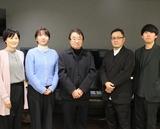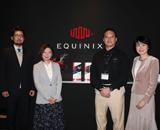March 2023
A World-Leading Digital Infrastructure Company: An Interview with Equinix
Equinix Japan K.K. is the Japanese branch of Equinix, Inc., a digital infrastructure company. Equinix is a major corporation with over 10,000 companies as its customers. It has grown continuously for over 20 years, increasing revenue for 79 consecutive quarters. Most of the world's prominent cloud services and providers, including Amazon Web Services (AWS), Azure by Microsoft, and Google Cloud, are built on Equinix's digital infrastructure. This is because the company provides an innovative environment that delivers the world's safest and most high-performing means to connect internet services between customers. Furthermore, as a global industry leader, Equinix is committed to sustainability efforts, making sustainability investments and actively encouraging employees to engage in volunteer activities.
In this interview, we asked Mr. Kiyomichi Arai, Product Marketing Manager at Equinix Japan, about the various initiatives of the company that operates leading-edge technologies around the world.

- Profile
- Kiyomichi Arai: Team Manager, Product Marketing, Equinix Japan
- Mariko Ohsato: CEO & President, Arc Communications Inc.
- Hiroaki Baba: Executive Manager, Translation & Localization Division, Arc Communications Inc.
- Mizue Itoh: Project Manager, Translation & Localization Division, Arc Communications Inc.
- Masafumi Ogawa: Sales, Translation & Localization Division, Arc Communications Inc.
A Data Center Business That Overturns Industry Norms
Ohsato: To begin, could you briefly introduce Equinix Japan?
Arai: Equinix provides the digital infrastructure used by most of the world's leading digital companies, such as Amazon, Microsoft and Google. Equinix customers are in the industry's largest global ecosystem, representing more than half of the Fortune 500 and more than one-third of the Forbes Global 2000.
Equinix was originally established as a neutral place where competing networks and internet exchanges (IX) could connect and share data traffic in 1998. In 2002, Equinix expanded in Japan. Not many people in the general public may be familiar with the term "IX." It is a facility that interconnects the networks of businesses like internet service providers and data centers, which exchange massive amounts of data with the outside. IX is an essential service to use the internet safely, at high speed and in large amounts. Back when the company was established, the internet was growing at an explosive speed overseas, and one of the issues that emerged was the arbitrary alteration of data and communication paths. To prevent this, people pointed out the necessity of creating a data center that offers neutral and independent IX. Equinix responded. For this reason, the company name "Equinix" is comprised of the words Equality, Neutrality and Internet Exchange.
Ohsato: When we previously talked, you said most Japanese companies try to keep the location of their data centers hidden for security reasons, but Equinix is open about that information. I found that very interesting. Why do you have your data centers in large cities rather than in the countryside?
Arai: As technologies advance, optical communication latency caused by cables stretching along long distances are becoming a problem. So, to improve response and achieve connections that can pursue even greater speed, we build data centers in large cities where they are physically closer to our customers instead of in the countryside. Companies likely hide the location of their data centers to avoid the risk of physical attacks, but Equinix has secured recovery capabilities (resiliency) in case of any breakdown by organically linking multiple data centers. Having this sort of countermeasure in place, we believe the benefits of being open about our locations--such as gaining the trust and support of community residents--outweigh the risks.
Baba: I understand that you have made meticulous adjustments to shorten the lead time until users can start using a data center.
Arai: Yes. For example, at Equinix, customers do not need to sign complicated contracts and can easily place an order by using the portal to fill in the necessary information. The setup takes less than 20 minutes, which reduces the customer's workload. But for people who manage many networks, even that is too much of a burden, so we made it possible to code the entire settings process (IaC: Infrastructure as Code). Setting up with IaC takes less than a minute and it leaves a log at the same time, so it's very convenient.
Baba: I also heard that you are putting a lot of effort into collaborations between customers.
Arai: Yes. Equinix connects customers and supports maximizing their businesses on Equinix's platform. In other words, we regard ourselves as a member of the ecosystem that builds a business environment in which our customers can collaborate, co-exist and prosper mutually. To this end, we offer Equinix Marketplace, which connects customers. Instead of it being a place where we simply sell Equinix solutions, we provide an environment in which companies that use Equinix can easily do business with each other.
Services That Enable Smooth Expansion Overseas
Baba: I heard that Japanese companies can benefit greatly from using Equinix's innovative services when working on overseas projects.
Arai: The reason I believe this company is innovative is because it always does unconventional things. Even as it adds more data centers in countries around the world, it creates services that do not need data centers. For example, let's say you want to open a large exhibition in Germany and temporarily need a digital infrastructure service as soon as possible. With Equinix services like Network Edge or Equinix Metal®, you do not need a data center contract but you can set up and construct IT equipment as if you were using a data center. Users can set up communication equipment and computers without software in around just 10 minutes and start using the service. Furthermore, with digital infrastructure services, you can choose the period of use by hour or day.
Baba: So, companies can expand globally very quickly and with great convenience.
Arai: Yes. Many of Equinix's customers have global businesses and over 89%*1 deployed with Equinix in multiple cities, including those located overseas. Equinix's services are very convenient since, with just one person overseeing things in the head office, the customer company can use all of our data centers and services around the world.
*1: Calculated from the ordinary revenue of the third quarter of 2022
Anticipation for Further Expansion in Asian Markets
Ohsato: What sort of challenges are you conscious of from a product marketing standpoint?
Arai: I feel we need to expand a little more into Asia. Just recently, we were able to announce the building of Equinix's first data centers in Indonesia and Malaysia. There are still many countries and metropolitan areas in Asia that are growing very rapidly, so I believe there are great opportunities for making future investments. In Japan, we announced the establishment of our 15th data center in Tokyo the other day.
Ohsato: When we think of foreign capital companies, we tend to picture their main marketing strategy as taking the practices that are best for all the group companies and implementing them on a global scale. How does Equinix approach translation?
Arai: What was the best at the time may no longer be the best half a year down the road, so strategies change all the time. In addition, we not only change the format but also the entire marketing content, so we need to re-translate it each time, which is a lot of effort. For example, we may steadily be putting together an operational manual of around 300,000 characters on a routine basis, but that may easily be replaced with something new. The same goes for the internal web portal.
Itoh: What is the headquarters' aim in implementing such drastic change to make things new?
Arai: It's to make our services more convenient and easier for customers to understand. For example, five years ago, we were hardly thinking about making our website multilingual. It was only available in English and several of our main business languages like Spanish, Japanese and so on. Later, we acquired a Brazilian company, so we needed to add Portuguese, and furthermore, localize. Today, we have nearly 30 foreign language sites and even switched platforms to handle them.
Feature Interview Index
















